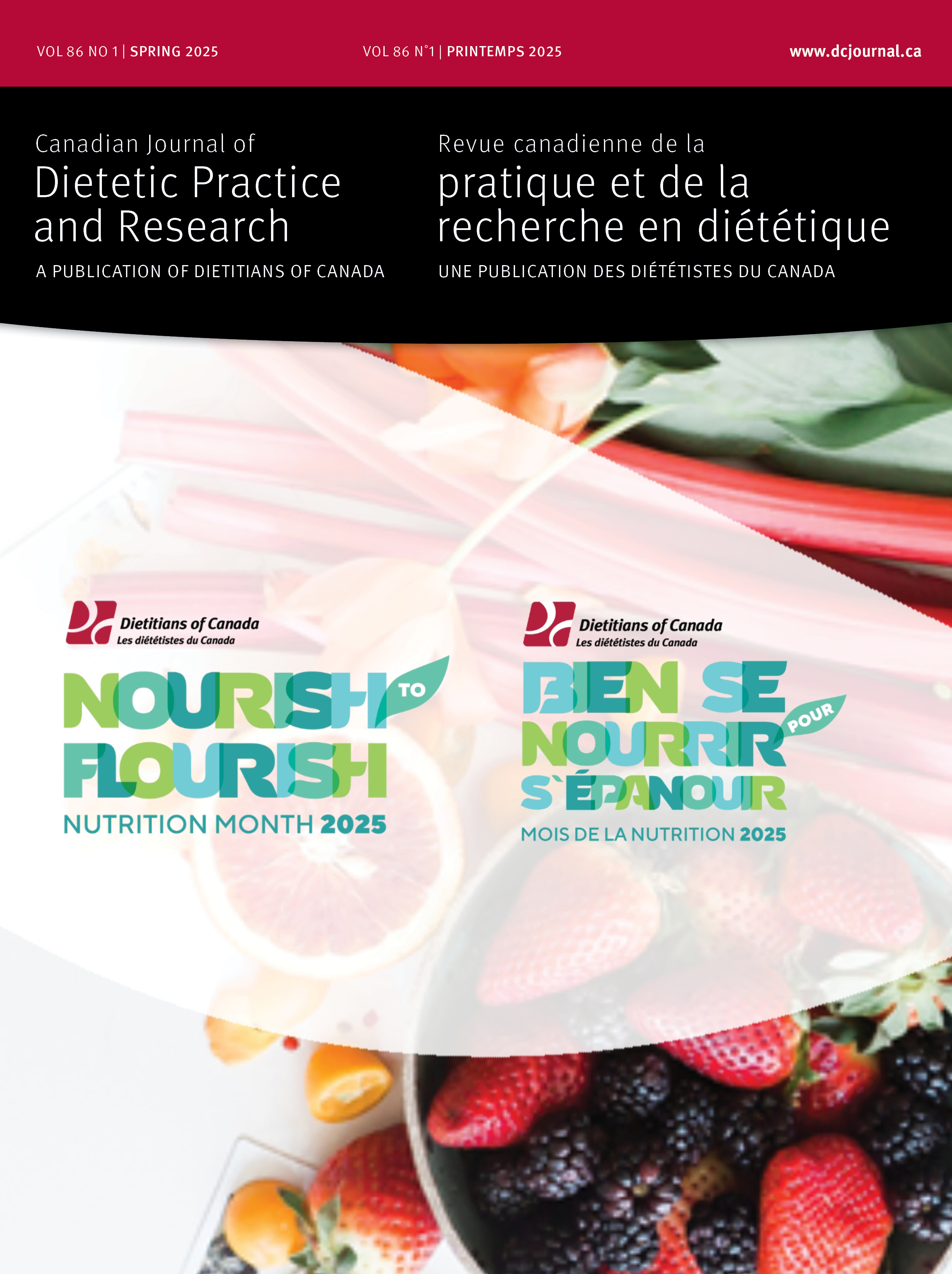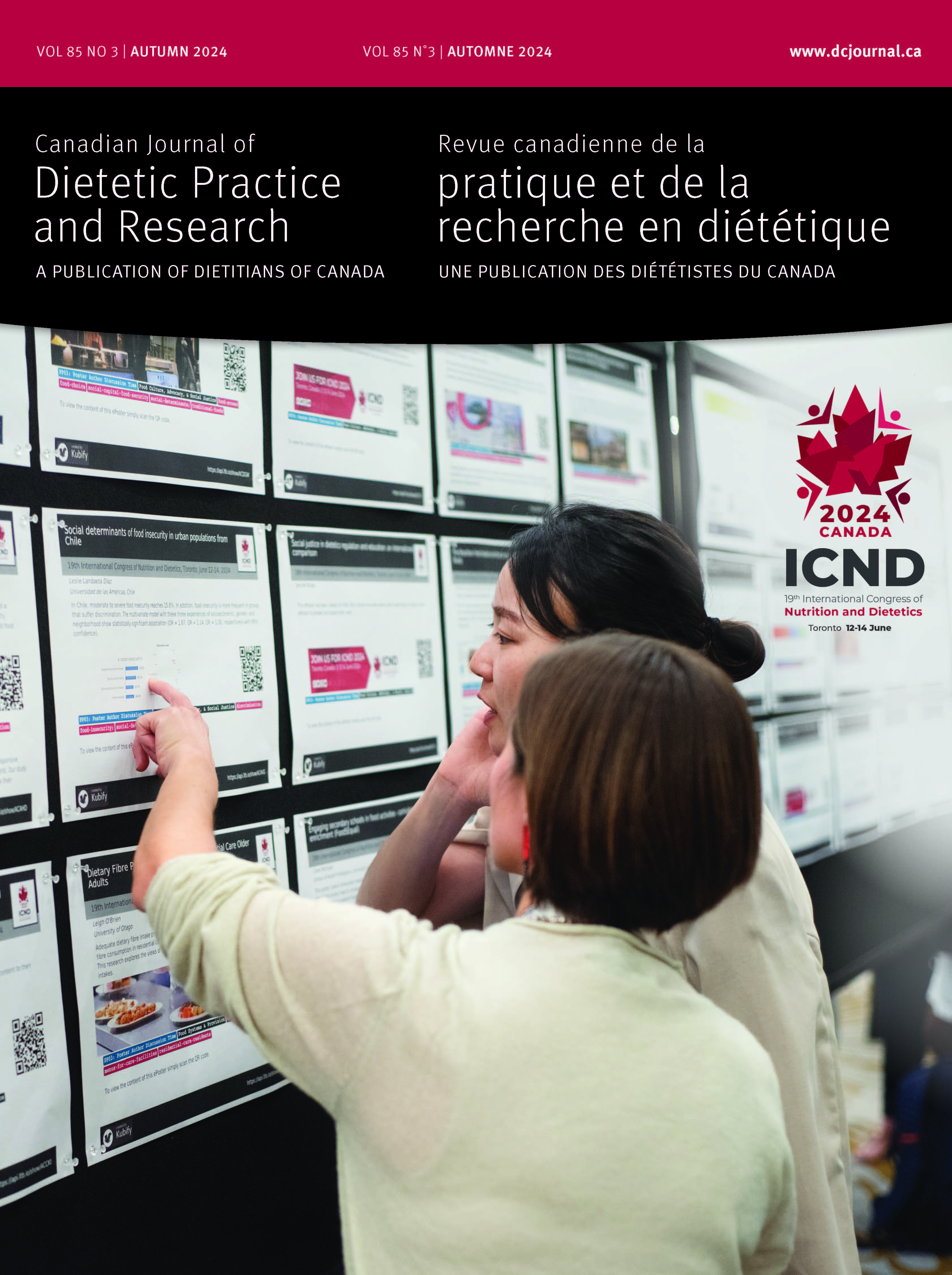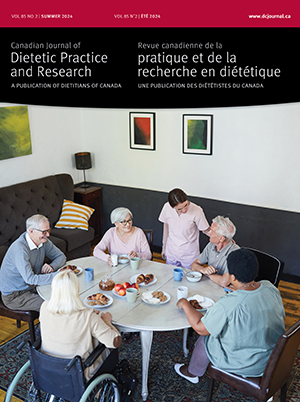Volume 83 • Number 1 • March 2022
Editor’s Message
Research
Purpose: The purpose of this paper is to understand Canadian dietitians’ use of the Nutrition Care Process (NCP) and terminology (NCPT) nationally and by province/territory as well as facilitators, barriers, and attitudes regarding the NCP/NCPT.Methods: Canadian dietitians were invited to complete an online survey (SurveyMonkey) on the NCP/NCPT from February to April 2017 through multiple channels. Data were analyzed using descriptive statistics and nonparametric tests.Results: Overall, there were 500 eligible respondents; the analysis focused on dietitians working in clinical care who were familiar with the NCP (n = 420). In total, 87.9% and 77.5% of respondents reported always/frequently using aspects of the NCP and NCPT in their practice, respectively. There were variations in use by province/territory (P < 0.001); use was more frequent in Alberta and Manitoba versus other provinces/territories. A main barrier to implementation was lack of time; main facilitators to implementation were peer support, management support, and required use of the NCP. The prevalence of many facilitators and barriers varied by province (P < 0.05). Attitudes regarding the NCP/NCPT were variable.Conclusions: Overall, most clinical care dietitians reported some type of use of the NCP/NCPT. There were provincial/territorial variations in use, barriers, and facilitators. These findings provide information to develop strategies to enhance use of the NCP/NCPT in Canada.
Purpose: To assess changes in dietary intake of adolescents following an 8-week aerobic exercise program.Methods: Twenty-six adolescents (14–18 years) participated in an 8-week aerobic exercise program on cycle ergometer at their high school in Quebec, Canada. Twenty-four hour recalls were collected pre- and post-intervention. A two-way repeated measures ANOVA and paired sample t-tests were used to assess differences in energy and dietary intake parameters (food quantity, diet quality, eating patterns) between pre- and postintervention.Results: A decrease in total daily energy intake (–287.8 kcal, P = 0.007), in meal size at lunch (–110.1 g, P = 0.02) and dinner (–143.7 g, P = 0.03), in food density at breakfast (–1.8 kcal/g, P = 0.04), in daily carbohydrate intake (–56.1 g, P = 0.005), and in percentage of energy intake consumed at school (–5.1%, P = 0.04) were observed following initiation of an aerobic exercise program. No change in healthy eating index scores or percentage of energy from processed foods was observed.Conclusions: Changes in energy intake, food quantity, and eating pattern but not diet quality (Healthy Eating Index or food processing scores) were observed following the initiation of an aerobic exercise program. Nutrition interventions may be needed, in addition to an exercise program, to target diet quality and promote healthy eating habits in adolescents.
Purpose: To describe (i) nutrition policies in childcare centres, (ii) the resources and processes used to enable policy implementation, and (iii) the association between policy implementation and childcare centres’ or administrators’ characteristics.Methods: Between October 2018 and June 2019 a web-based survey that addressed nutrition policy, policy implementation, and sociodemographic characteristics was sent to eligible childcare programs (centre-based and provided meals) in the Edmonton (Alberta) metropolitan region. The survey was pretested and pilot tested. Statistical tests examined the relationship between policy implementation with centres’ and administrators’ characteristics.Results: Of 312 childcare centres that received the survey invitation, 43 completed it. The majority of centres had a nutrition policy in place (94%). On average, centres had about 9 of the 17 implementation resources and processes assessed. Most often administrators reported actively encouraging the implementation of the nutrition policy (n = 35; 87%) and least often writing evaluation reports of the implementation of the nutrition policy (n = 9; 22%). Administrator’s education level was associated with implementation total score (p = 0.009; Kruskal-Wallis).Conclusion: Most childcare centres had a nutrition policy in place, but many lacked resources and processes to enable policy implementation. Additional support is required to improve nutrition policy development and implementation.
Perspectives in practice
OPEN ACCESS
Keenoa™ is a novel Canadian diet application (app) currently used by Canadian dietitians to collect diet-related data from clients. The goal of this study was to evaluate Keenoa™ based on user feedback and compare it to a conventional pen and paper method. One hundred and two participants were recruited and randomly assigned to record their diets using this application for 3 nonconsecutive days. Following this, participants were invited to complete an online “exit” survey. Seventy-two subjects responded, with 50 completing an open-ended question asking for general feedback about the app. Data were reviewed and 3 main themes emerged: strengths, challenges, and future recommendations. Strengths associated with the app consisted of picture recognition software, the additional commentary feature, and the overall pleasant data collection process. Challenges that were identified included inconsistencies with the barcode scanning features, the limited food database, time to enter food details, and software issues. Future recommendations included using a larger food database, pairing dietary intake with physical activity monitoring, and having accessible nutritional data. Despite these limitations, participants preferred using mobile apps to record diet compared with traditional written food diaries.
Automated Self-Administered 24-hour Dietary Assessment (ASA24) is an economical method of estimating dietary intake as nutrient analysis is automated, but its use in older adults is limited. The purpose of this work was to guide dietitians and future researchers on how to use the ASA24 with older adults, considering potential barriers encountered and strategies used to support completion based on our experience using this tool in a pilot clinical trial. ASA24 was completed by phone interview with 39 older adults. Challenges included: recalling food intake in detail, recording frequent eating occasions and complicated recipes, and general problems with communication. Strategies to support collection included making morning phone calls and suggesting that seniors write down the food consumed. Phone interviews were acceptable to older adults, but sufficient time was required. Dietitians and future researchers can use these findings to obtain dietary intake data from this hard-to-reach group.
The purpose of this study was to assess the perceptions and practices around physical activity counselling and exercise prescription of dietitians in Nova Scotia. Dietitians (n = 95) across Nova Scotia completed an online self-reflection survey regarding their current physical activity and exercise (PAE) practices. Most (51%; n = 48) reported no previous PAE educational training. Dietitians infrequently prescribed exercise to their patients (16% ± 26% of appointments) or provided PAE referrals (17% ± 24%). Dietitians reported moderate confidence (57% ± 21%) performing PAE counselling and included PAE-related content in half of patient appointments (52% ± 31%). Almost all respondents (95%) identified interest in further PAE education or training. Open-ended responses also demonstrated the need for community-based exercise programs (28% of providers) and qualified exercise professionals to refer to (25%). Overall, dietitians report rarely providing patients with written exercise prescriptions or referrals to other professionals for PAE content but do frequently include PAE in patient appointments. Dietitians in Nova Scotia are well positioned to promote PAE, but more educational training and improved referral systems to qualified exercise professionals or community exercise programs is strongly desired. Exercise professionals and dietitians should concurrently advocate for these changes and collaborate to help more patients lead physically active lifestyles.
The Prenatal Nutrition Tool was created for care providers that work with pregnant clients and aims to support focused conversations on nutrition topics that influence maternal and infant health outcomes. A systematic 9-step product development process that combined findings from the literature with perspectives of nutrition experts and care providers was used to develop the tool. The results of a literature review and a modified Delphi Process (to obtain expert opinion) laid the foundation for the tool content. The final tool incorporated client feedback. More specifically, client feedback helped to refine tool questions. The tool consists of 2 parts: a questionnaire (written survey) and a conversation guide. The questionnaire covers 4 key themes (pregnancy weight gain, multivitamins, life circumstances, overall food intake) in 13 questions. The conversation guide utilizes public health nutrition guidance documents to lead care providers in focused discussions with clients. The tool is not intended to be a screening tool for medical conditions or replace an in-depth prenatal nutrition assessment. The tool can be accessed by any care provider in Canada on the Alberta Health Services website at Prenatal Nutrition Tool | Alberta Health Services.
Report
Purpose: To identify key attributes of Canadian clinical registered dietitian (RD) jobs associated with high rates of turnover.Methods: Managers of clinical RDs in Canada were eligible to complete a survey on the topic of turnover in clinical RD positions. Specifically, key details were sought regarding positions with the highest and lowest turnover in each manager’s portfolio.Results: High turnover (HT) positions turned over an average of 4.0 times in a 5-year period in contrast to 0.3 times in low turnover (LT) positions. Resignation was the top reason for turnover in both HT and LT positions. HT and LT positions were of analogous full-time equivalent, had comparable caseloads, and served clients/patients with similar diagnoses including diabetes and neurological conditions.Conclusions: There is significant variation in the frequency of turnover across positions in clinical dietetics in Canada. What differentiates HT positions from LT positions remains unclear. More research is required to guide managers seeking to balance turnover and preclude uneven nutrition care quality across units and programs.










